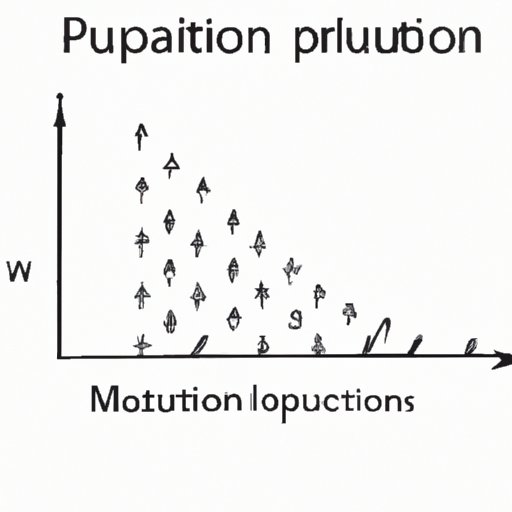
I. Introduction
Population mean is an essential concept in statistics and mathematics. Understanding and calculating it accurately is crucial in making informed decisions in various fields, from social sciences to business and healthcare. This article aims to provide a comprehensive guide to finding population mean, from defining the term to exploring efficient methods for calculations, and tips and tricks to help you improve and avoid common mistakes. It is designed to provide a beginner-friendly approach to a complex topic, suitable for anyone interested in statistics and calculations but not necessarily an expert.
II. A Beginner’s Guide to Finding Population Mean
Before diving into the technicalities of population mean calculation, it’s important to define the term. Population mean, also known as the arithmetic mean, is the average value of a given population or a whole dataset. It’s calculated by dividing the sum of all values in the population by the total number of values.
It’s important to note the difference between sample mean and population mean. Sample mean is the average value of a selected subset of a population, while population mean is the average value of the entire population.
Population mean is essential in making decisions that involve the entire population, as opposed to just a sample. For example, if you’re a healthcare researcher studying the prevalence of a disease, knowing the population mean can help you identify the most efficient intervention strategy. Similarly, if you’re a business owner analyzing customer satisfaction levels, population mean can help you identify areas for improvement in your product or service.
III. Solving for Population Mean: Step-by-Step Tutorial
Now that we’ve defined and established the importance of population mean, let’s dive into the step-by-step tutorial on how to calculate it.
The formula for population mean is as follows:
Population Mean = (Sum of all values in the population) / (Total number of values in the population)
Let’s say we have a population of ten values: 2, 3, 5, 6, 7, 8, 9, 10, 12, and 15. To calculate the population mean, we need to follow these steps:
- Find the sum of all values in the population. Sum = 77.
- Count the total number of values in the population. Total number of values = 10.
- Divide the sum of all values by the total number of values. Population Mean = 77 / 10 = 7.7.
Therefore, the population mean for this particular dataset is 7.7.
It’s essential to note that population mean can be influenced by extreme values or outliers in the dataset. It’s always a good practice to examine your data for any anomalies or outliers before calculating population mean.
IV. Mastering the Art of Calculating Population Mean: Tips and Tricks
Calculating population mean can be a time-consuming process, especially if you’re dealing with large datasets. Here are some tips and tricks to help you improve your accuracy and simplify your calculations:
- Use a calculator or statistical software to avoid manual errors and simplify your calculations.
- Round off your final answer to an appropriate number of decimal places to maintain accuracy while improving readability.
- Break down your calculations into smaller, simpler tasks to reduce errors and improve efficiency.
- If you’re dealing with complex datasets, consider using specialized formulas or software to simplify your calculations.
V. Why Knowing Population Mean Matters: An Exploration
Population mean plays a crucial role in decision-making processes in various fields. Here are some reasons why knowing population mean matters:
- Helps identify trends and patterns in a population and informs effective decision-making.
- Helps make predictions about future events or trends in a given population.
- Provides valuable insights into the performance of a product or service and helps identify areas for improvement.
Knowing the population mean is essential in making informed decisions in scenarios where the entire population is involved, such as in healthcare or social policy research.
VI. Efficient Methods for Finding Population Mean
As we mentioned earlier, calculating population mean can be complex and time-consuming, especially if you’re dealing with large datasets. Here are some techniques to help you improve efficiency when finding population mean:
- Use specialized software to automate the calculation process. This software can help you find population mean accurately and efficiently.
- Use a weighted mean formula to calculate population mean when dealing with datasets that have varying importance or weightage.
- Take advantage of online calculators or spreadsheets to simplify calculations.
Choosing the right method for finding population mean largely depends on the complexity and size of the dataset.
VII. Common Mistakes in Calculating Population Mean and How to Avoid Them
Even with the best calculations, mistakes can happen when finding population mean. Here are some common mistakes to avoid:
- Confusing population mean with sample mean. Make sure you’re calculating the right mean for your dataset.
- Forgetting to divide the sum of values by the total number of values in the population. This is a crucial step in finding population mean.
- Summing up the wrong values in the dataset. Make sure you’re selecting the correct values for the calculation.
- Ignoring outliers in the dataset. Outliers can significantly impact population mean calculations.
To avoid these common mistakes, it’s essential to double-check your calculations and review your dataset before proceeding with the calculations.
VIII. Conclusion
In conclusion, understanding and calculating population mean is crucial in making informed decisions in various fields. We covered a beginner-friendly approach to population mean, including defining the term, explaining the formula, providing a step-by-step tutorial, and exploring tips and tricks for improving accuracy and efficiency. We discussed the importance of population mean, efficient methods for finding it, and common mistakes to avoid. With the right approach, anyone can master the art of population mean calculations, and we encourage you to practice and improve your skills.




